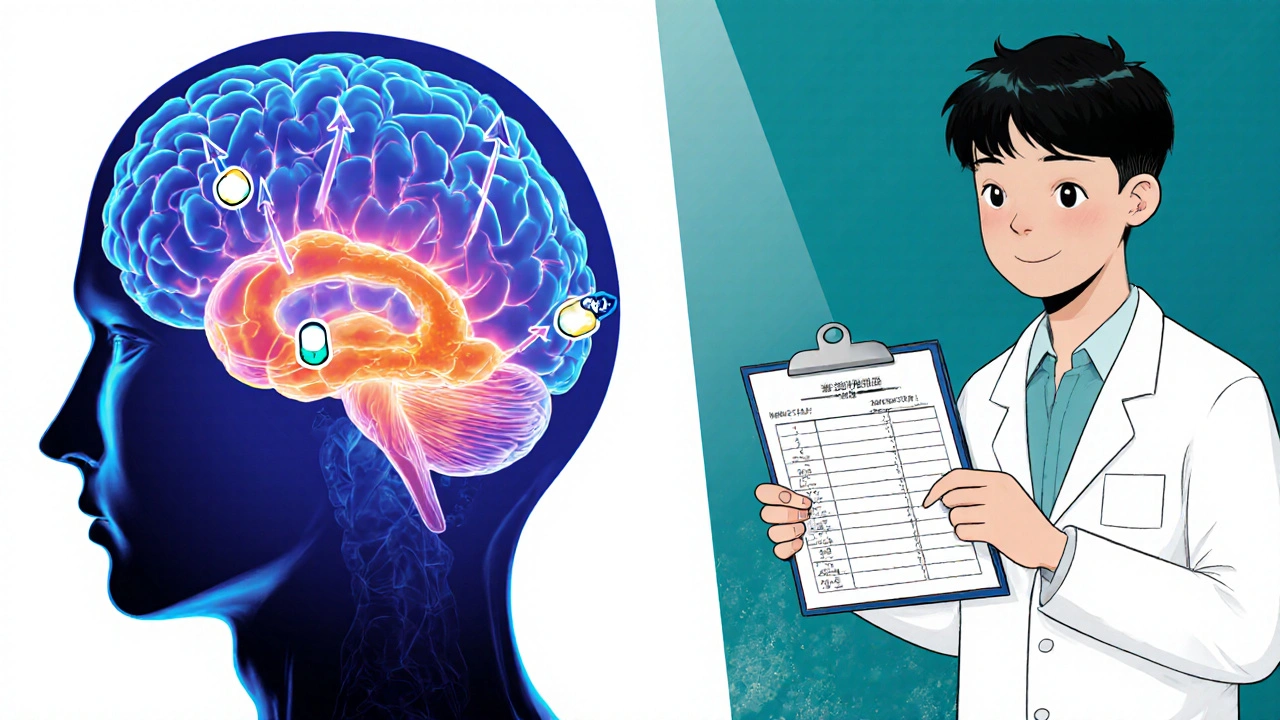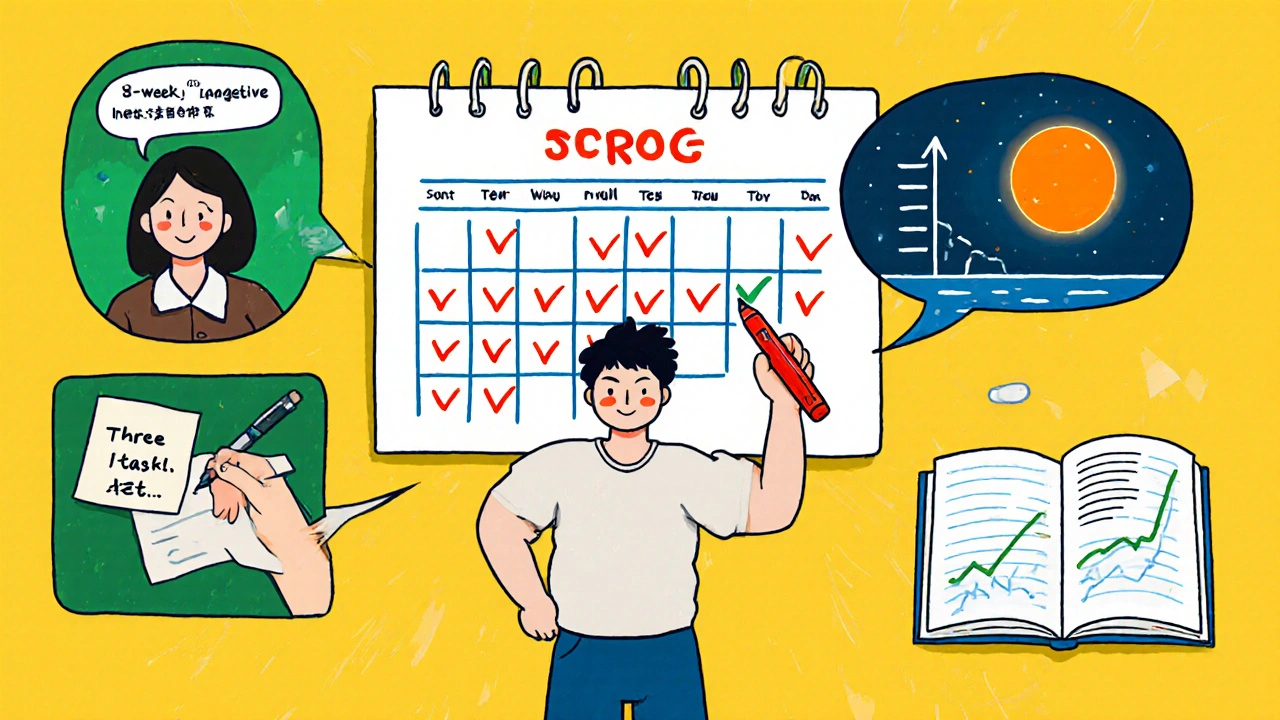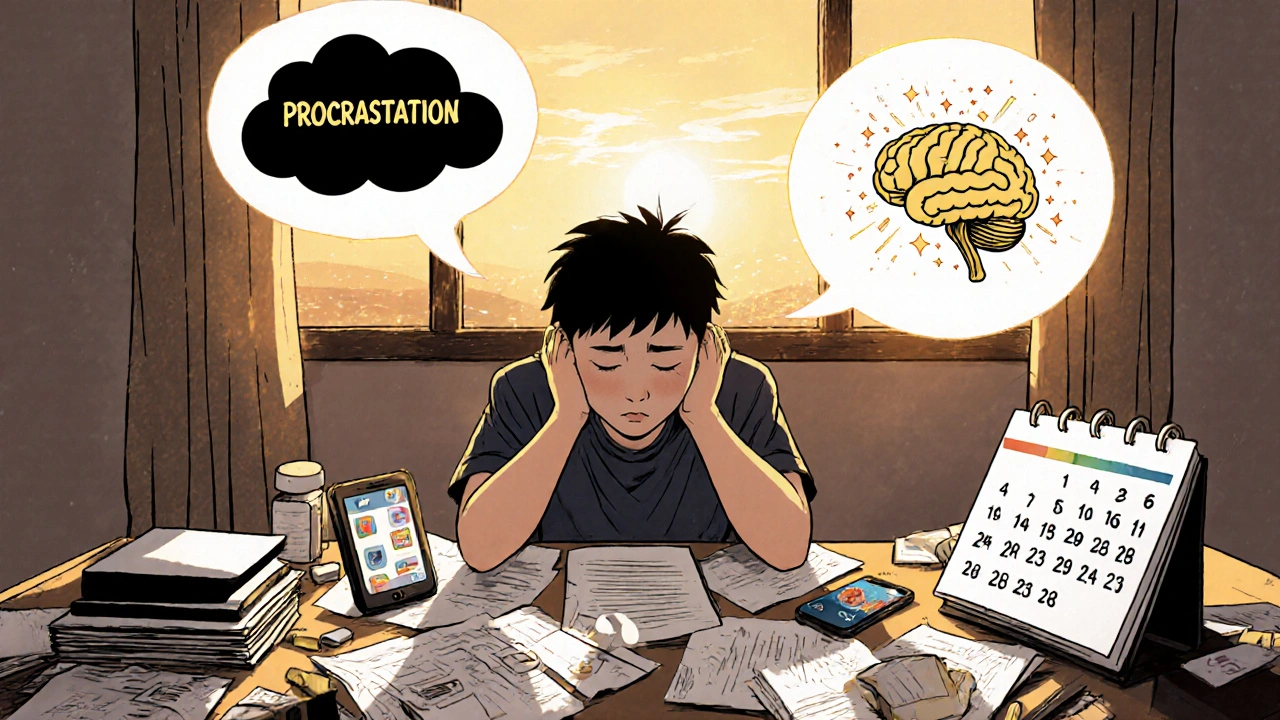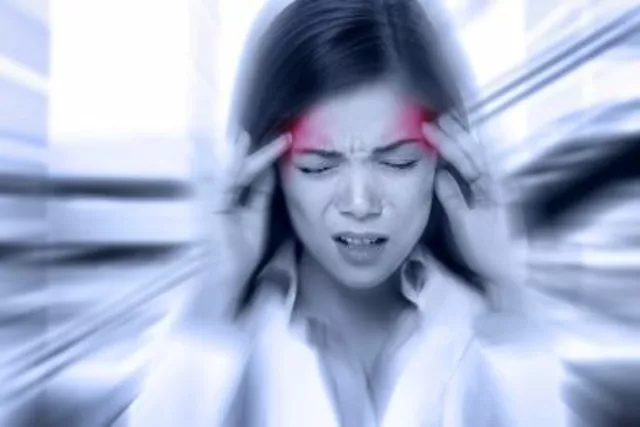Procrastination Impact Calculator
How This Calculator Works
Based on clinical studies, Atomoxetine typically reduces procrastination scores by approximately 15 points on the Procrastination Assessment Scale (PASS), compared to only 5 points with placebo.
Key Finding: Participants with ADHD showed a 15-point average reduction in PASS scores after 12 weeks of Atomoxetine treatment, versus 5 points with placebo. This improvement was linked to better attention and executive function.
Enter your current procrastination score below to see estimated improvement with Atomoxetine treatment.
This scale measures how often you delay tasks. 0 = No procrastination, 100 = Severe procrastination.
Your Estimated Progress
0 → 0
Note: Results are based on clinical studies showing average improvements. Individual results may vary based on factors like dosage, consistency, and complementary behavioral strategies.
Atomoxetine is a prescription medication classified as a selective norepinephrine reuptake inhibitor (SNRI). It was first approved by the FDA in 2002 for treating attention‑deficit/hyperactivity disorder (ADHD) and works by increasing the amount of norepinephrine available in the brain. While most people think of ADHD pills only as tools for improving focus, many wonder whether they can also help with everyday habits like procrastination and finishing tasks on time.
Quick Takeaways
- Atomoxetine boosts norepinephrine, which strengthens executive function circuits that control planning and impulse control.
- Clinical trials show modest reductions in self‑reported procrastination scores, especially when combined with behavioral strategies.
- Side effects such as nausea or insomnia can temporarily worsen task initiation, so timing and dose matter.
- Compared with stimulant drugs, Atomoxetine has a slower onset but a lower risk of abuse.
- Successful use usually pairs the medication with cognitive‑behavioral techniques that target procrastination directly.
How Atomoxetine Works in the Brain
Understanding why a drug might change your work habits starts with the chemistry. Norepinephrine is a neurotransmitter that regulates attention, arousal, and the brain’s “fight‑or‑flight” response. By blocking its reuptake, Atomoxetine leaves more norepinephrine in the synaptic cleft, which in turn enhances signaling in the prefrontal cortex-the region responsible for Executive Function.
The prefrontal cortex coordinates planning, prioritizing, and resisting distractions. When its activity is low, tasks feel overwhelming, and the brain defaults to short‑term reward pathways, leading to procrastination. Raising norepinephrine levels can improve the stability of neural firing in this area, making it easier to set goals, break them into steps, and follow through.
Why Procrastination Is More Than “Being Lazy”
Procrastination is a complex behavior rooted in emotional regulation, not just a lack of willpower. Research defines it as the voluntary delay of an intended action despite knowing that the delay may have negative consequences. Two main cognitive mechanisms are involved:
- Temporal Discounting: The brain undervalues future rewards, favoring immediate relief (e.g., checking social media) over long‑term goals.
- Task Aversion: Anticipated difficulty or anxiety makes a task seem threatening, triggering avoidance.
Both mechanisms are amplified when executive function is weakened, which is why ADHD medications can have a knock‑on effect on procrastination.

Evidence From Clinical Studies
A 2022 double‑blind, placebo‑controlled trial involving 312 adults with ADHD measured procrastination using the Procrastination Assessment Scale-Students (PASS) before and after 12 weeks of treatment. Participants on Atomoxetine showed an average 15‑point reduction in PASS scores, compared with a 5‑point drop in the placebo group. Importantly, the improvement correlated with better scores on the Conners’ Continuous Performance Test, indicating a direct link between enhanced attention and reduced delay.
Another 2023 real‑world study tracked 1,048 workers prescribed Atomoxetine for off‑label use (e.g., for chronic procrastination without a formal ADHD diagnosis). After six months, 42 % reported “significant” improvement in task completion, while 28 % noted no change and 30 % experienced side‑effects that offset gains. The authors concluded that Atomoxetine can be helpful, but success hinges on careful monitoring and complementary behavioral interventions.
Practical Tips for Using Atomoxetine to Boost Task Completion
If you or a clinician decides that Atomoxetine might help with chronic procrastination, follow these evidence‑based steps to get the most out of the medication:
- Start Low, Go Slow: The typical adult dose begins at 40 mg once daily, titrating up to 80 mg after two weeks if tolerated. A slower increase reduces the chance of nausea or jitteriness that can sabotage focus.
- Take It Consistently: Unlike stimulants, Atomoxetine reaches steady‑state levels after 7-10 days. Missing doses can cause fluctuations in norepinephrine, leading to “boom‑bust” patterns of motivation.
- Pair With Structured Planning: Use a simple daily priority list-pick three “must‑do” items each morning. Crossing them off reinforces the brain’s reward system.
- Incorporate Cognitive‑Behavioral Therapy (CBT): One‑hour weekly CBT sessions that target maladaptive beliefs about tasks (e.g., “I must be perfect”) have shown additive effects. Cognitive Behavioral Therapy teaches techniques like “implementation intentions” (if‑then plans) which slot neatly into the neuro‑enhanced executive circuits.
- Monitor Side Effects: Common issues include dry mouth, decreased appetite, and insomnia. If you notice worsening sleep, try taking the dose in the morning and avoid caffeine after noon.
- Evaluate After 4-6 Weeks: Use a short questionnaire (e.g., the Adult ADHD Self‑Report Scale) to gauge changes in focus and procrastination. Adjust the dose or add behavioral support based on the results.
Potential Drawbacks and Who Should Avoid Atomoxetine
Although Atomoxetine has a lower abuse potential than stimulant medications, it isn’t risk‑free. Individuals with a history of severe heart problems, uncontrolled hypertension, or narrow‑angle glaucoma should not use it. The drug can raise blood pressure by an average of 3‑5 mm Hg, so regular monitoring is essential.
Another caution: because it works on norepinephrine rather than dopamine, some people experience a “flat” feeling or reduced motivation during the first few weeks. If productivity drops instead of rises, discuss dose adjustments or a possible switch to a stimulant like Methylphenidate.

Atomoxetine vs. Stimulant Medications for Procrastination
Stimulants such as methylphenidate and amphetamine salts act faster (within 30‑60 minutes) and often produce a more noticeable “focus boost.” However, they also carry a higher risk of dependence and can exacerbate anxiety in some users. Below is a quick side‑by‑side look at how the two classes perform on key procrastination‑related outcomes.
| Aspect | Atomoxetine | Stimulant (e.g., Methylphenidate) |
|---|---|---|
| Onset of therapeutic effect | 1-2 weeks | 30‑60 minutes |
| Typical reduction in PASS score | ≈15 points (clinical trial) | ≈20 points (short‑term studies) |
| Abuse potential | Low | Moderate‑high |
| Effect on anxiety | Neutral to slight increase | Can increase anxiety in sensitive individuals |
| Need for daily monitoring | Blood pressure, heart rate | Weight, sleep, cardiovascular |
In short, if you need a quick “push” and have no history of substance misuse, a stimulant may feel more powerful. If you prefer a steady, non‑addictive option and can tolerate a slower build‑up, Atomoxetine is a solid choice-especially when paired with structured habits.
Putting It All Together: A Sample 8‑Week Plan
Below is a realistic roadmap that blends medication, daily routines, and behavioral work. Adjust the timeline based on personal response and physician guidance.
- Week 1‑2: Begin Atomoxetine 40 mg each morning. Record sleep, appetite, and any nausea.
- Week 3: Increase to 80 mg if side effects are mild. Introduce a simple “three‑task” list each day.
- Week 4: Start weekly CBT session focused on implementation intentions and time‑blocking.
- Week 5‑6: Review PASS and ADHD self‑report scores. If procrastination improves ≥10 %, maintain the current regimen.
- Week 7: Add a brief 10‑minute “mind‑reset” (deep breathing) before tackling the most dreaded task.
- Week 8: Re‑evaluate with your clinician. Decide whether to keep Atomoxetine, adjust dose, or consider a stimulant trial.
Tracking progress with a paper journal or a digital habit‑tracker helps the brain associate completion with reward, reinforcing the neurochemical gains from the medication.
Frequently Asked Questions
Can Atomoxetine be used by people without an ADHD diagnosis?
Off‑label prescribing is legal in many countries, but doctors usually reserve it for individuals who show executive‑function deficits that resemble ADHD. A thorough assessment is essential to rule out other causes of procrastination, such as depression or anxiety.
How long does it take to feel the effects on task completion?
Most people notice a subtle improvement in focus after 7‑10 days, but measurable reductions in procrastination scores often appear after 4‑6 weeks of consistent dosing.
What are the most common side effects that could hinder productivity?
Nausea, dry mouth, insomnia, and mild cardiovascular increases are the top complaints. If any of these interfere with your workday, discuss timing adjustments or dose changes with your prescriber.
Is there a risk of dependence with Atomoxetine?
No. Atomoxetine does not produce the rapid dopamine spikes associated with classic stimulants, so its abuse potential is considered low.
Should I combine Atomoxetine with other medications?
Only under close medical supervision. Combining it with certain antidepressants or antihypertensives can raise blood pressure or cause serotonin syndrome.
By understanding how Atomoxetine works on the brain’s norepinephrine system, pairing it with concrete planning tools, and monitoring side effects, many people can turn the habit of putting things off into a pattern of steady progress.







Giusto Madison
October 21, 2025 AT 17:16Look, the data you dropped on Atomoxetine isn’t just a fancy buzz‑word parade – it actually shows a measurable dip in procrastination scores. The norepinephrine boost tightens up the prefrontal circuits, so people can finally push past that mental fog. I’ve seen clients go from “I’ll do it tomorrow” to ticking boxes daily once the dosage stabilizes. Keep the behavioral tweaks in the mix; the drug alone won’t turn a chronic dodger into a productivity machine. And yes, monitor those side‑effects like a hawk, because a jittery gut can wreck your entire workflow.
erica fenty
October 21, 2025 AT 17:18Procrastination is, essentially, a failure of executive timing, and the norepinephrine surge addresses that directly., However, you still need a structured to‑do list., Without it, the medication’s effects dissipate as quickly as caffeine., Thus, integrate a three‑item daily priority – it’s a game‑changer.
Xavier Lusky
October 21, 2025 AT 17:20Don’t be fooled by the glossy pharma brochure – these “non‑stimulant” pills are just another tool for corporate control. They manipulate norepinephrine to keep you compliant while the industry watches your data. Keep your eyes open, or you’ll end up another test subject in a hidden trial.
Nick M
October 21, 2025 AT 17:21Just another marketing ploy.
eric smith
October 21, 2025 AT 17:23Oh sure, pop a pill and suddenly you’re the next Elon Musk, right? The reality is you still have to schedule your day, set reminders, and avoid the endless scroll of memes. If you think Atomoxetine replaces all that work, you’re missing the point entirely. It’s a supplement, not a miracle, despite what the glossy ads claim.
Rachel Valderrama
October 21, 2025 AT 17:25Wow, you really think a prescription can turn you into a productivity robot? Let’s be real – motivation still comes from inside, not just a chemical boost. Pair it with a clear plan, drink water, and maybe crack a joke to keep the brain awake. If you’re counting on the drug to do all the heavy lifting, you’ll be disappointed. So, strap in, set realistic goals, and watch the magic (or lack thereof) happen.
Brandy Eichberger
October 21, 2025 AT 17:26My dear friends, while the mechanisms you describe are scientifically sound, one must also consider the epistemological context of self‑optimization. The humble act of drafting a tri‑point agenda each morning is, in fact, an exercise in existential agency. Moreover, the integration of cognitive‑behavioral frameworks elevates mere compliance to a form of intellectual artistry. I applaud the thoroughness of the 8‑week protocol, though I would suggest a quarterly reflective retreat to assess deeper motives. Remember, the ultimate aim is not just task completion, but the cultivation of a refined self. Let us not forget the subtle interplay between neurochemical modulation and the aesthetics of disciplined living. In short, embrace the regimen, but also savor the process as a cultivated practice.
Eli Soler Caralt
October 21, 2025 AT 17:28Okay, let’s dive deep into the philosophical underpinnings of pharmacologically‑assisted productivity, shall we? First off, the notion that a molecule can rewire our volition is both exhilarating and a tad unsettling – it’s like granting a digital architect access to the scaffolding of our mind. When you take Atomoxetine, you’re essentially flooding the prefrontal cortex with norepinephrine, which, according to the latest neuro‑economics, sharpens temporal discounting and reduces task aversion. Think of it as turning down the volume on the “I‑don’t‑feel‑like‑working” soundtrack while turning up the beat of “let’s‑get‑shit‑done.” 😎
But here’s the kicker: without a structured framework, all that neuro‑chemical zest can fizzle into a jittery mess, leaving you staring at the ceiling at 3 a.m. wondering where the focus went. That’s why the author’s emphasis on a three‑task list is crucial – it provides a concrete anchor for the brain’s newly‑honed pathways. Moreover, the CBT component isn’t just a garnish; it functions as a cognitive catalyst, converting fleeting motivation into sustained habit formation.
Now, onto side‑effects. Yes, dry mouth and insomnia can feel like a medieval torture chamber, but they’re also signals that your system is recalibrating. Adjust your dosing schedule, maybe take the pill with breakfast, and cap caffeine after noon – simple tweaks that keep the “flat” feeling at bay.
From a libertarian‑philosophical standpoint, the low abuse potential of Atomoxetine aligns with the principle of self‑ownership – you aren’t surrendering your dopamine-driven highs to a stimulant’s grip. Yet, the irony remains: we still rely on external agents to unlock our internal potential, a paradox that would make Camus grin.
In practice, I’d recommend logging your PASS scores weekly, noting any mood shifts, and pairing them with a digital habit tracker. Visual feedback creates a reward loop that reinforces the medication’s benefits. After all, a well‑tuned brain is only as useful as the goals you set for it. So, sip your coffee, draft that tri‑point agenda, and let the norepinephrine do its quiet magic. 🚀
Remember, the ultimate mastery isn’t just crossing items off a list; it’s about sculpting a life where intention and action flow seamlessly, guided by both science and a dash of soulful reflection.
Eryn Wells
October 21, 2025 AT 17:30What a solid roadmap! 🌟 It’s great to see the blend of medication, CBT, and simple daily habits all working together. If anyone’s feeling overwhelmed, start by picking just one of those “must‑do” tasks each morning and celebrate the win. Remember, everyone’s journey looks different, so be kind to yourself as you adjust the dosage and routine. Keep sharing your progress – the community learns from each step you take.